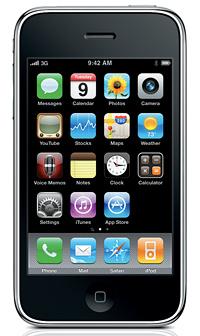Mobile Gets App Happy

It's always great to be a firsthand witness to an "Aha!" technology moment heralding a new apocalypse, and my latest came last week at a hipster karaoke destination. My friend couldn't wait to show me her new posh, pristine-white iPhone—and then she couldn't keep her hands off it.
But as she gushed about all its dazzling doohickys, along came our Japanese friend to out-hipster her. And he fit the part perfectly: big black hipster glasses, hair product starching a helmeted crest, and a t-shirt with a giant, raised band-aid on it.
Whipping out his iPhone in one hand (his other brandished a large bottle of Sapporo), he summoned an app and held up his display to evoke my friend's quick gasp. On his screen, like a radar readout horizontally aligned, gleamed the locations and Yelp customer ratings of multiple nearby restaurants. As he rotated 360 degrees, the GPS-generated locations stayed fixed, allowing the user to navigate easily toward any of them.
In one rarefied moment, the future of broadband beckoned: it's mobile, it's hip, it's socially connected—and it's all about the killer apps.
I wrote about this coming seachange in October 2008, when Android, Google's mobile 3G OS, was making some big splashes. At the time I hailed mobile broadband as the space where the future of broadband could be found, in part because of Android's open-platform development.
All trends are now accelerating in that direction.
The mobile handset industry has been remarkably recession-proof, even more notable because consumers are eschewing cheaper phones and flocking to pricier 3G smartphones. Android-equipped phones are forecast to grow an eye-popping 900 percent this year, according to research firm Strategy Analytics, which also predicts a strong 79 percent growth rate for Apple's iPhone.
Ad revenues generated by the phones have also seen steep increases. Though research firm Kelsey Group says mobile ads last year drew a mere $160 million—that's a pittance compared to the $23 billion-plus spent on online ads, according to the Internet Advertising Bureau—search advertising alone on U.S. cell phones is projected to rise to $1.5 billion by 2012, according to research firm eMarketer.
Most analysts see a surge coming in smartphone and mobile ad sales, especially as holiday shoppers gravitate towards a sizzling lineup of new devices.
Legitimizing this ad trend, Google plunked down $750 million on Nov. 10 to acquire AdMob, a mobile ad startup that finds ways to put advertising on cellphones. Admob is a pioneer in selling banner ads that run in smartphone apps, and Google's move reveals its long-term plan for mobile broadband domination. AdMob is its third largest acquisition to date, after DoubleClick ($3.1 billion last year) and YouTube ($1.65 billion in 2006).

Google execs have gone public with a bold prediction: that they will one day make more money from mobile ads than in their fixed-line ad business.
GOTTA HAVE THAT APP
The most convincing factor on their side lies in the killer apps that are flying off virtual store shelves.
Since Apple debuted its App Store last year its lineup has grown to more than 100,000 apps, and more than two billion have been downloaded. While one-hit wonders make up the vast majority, some have been spectacular hits. Shazam, which allows a cellphone to "hear" a tune, identify it, then download it from iTunes, has drawn 50 million users.
This has triggered three seismic shifts that need to be seen in concert to grasp the deeper implication.
First, other smartphone OS alliances, from Android to Nokia's Symbian to Research in Motion's Blackberry to Palm's new Linux-based OS to Samsung's new Bada, have raced to update their own OS releases and open and stock their own app storefronts.
Second, while Shazam and others have yet to iron out their revenue models, their success has been galvanizing the emerging smartphone OS developer community. Think of a giant magnet drawing the best and brightest brains, all looking for the big score. Mobile research firm Flurry reports new Android developer projects have nearly doubled, sparked in part by new Android 2.0 smartphones such as the Motorola Droid.
Third, venture capital players are placing heavy bets on Shazam and others, providing badly needed seed money in tight times.
It's the perfect storm of competition, customers, ad revenues, creativity, investment, technological development, and new, useful products and services at fair prices. All of which has been lacking for years in mobile broadband's antecedent.
STATIC BROADBAND IS SO, LIKE, STATIC
The fermentation we're seeing in the mobile broadband space should send clear warnings to FCC regulators examining the fixed-line broadband environment. That landscape has been long dominated by two players: cable operators controlling the pipes and Microsoft's browser and OS to access those pipes, which have stifled the kind of competition now energizing mobile broadband. (While Microsoft has its own latest smartphone OS release, it's hardly making a peep).
Other than the aforementioned YouTube, social networking sites like Facebook and MySpace, and their recent evil stepchild, Twitter (none of which came about because of cable or Microsoft investment), what has that environment produced in terms of breakthrough broadband content?
When I started in this business, covering emerging cable programming networks in the mid-1990s, their leading executives proclaimed, "Content is King."
It still is. And regulators need to remember, and preserve, the factors that create exciting content.
Will Workman is a former editor of telco industry publications Cable World and MediaView. He is now working on his Ph.D. in mass communications. He can be reached care of TV Technology.
Get the TV Tech Newsletter
The professional video industry's #1 source for news, trends and product and tech information. Sign up below.
